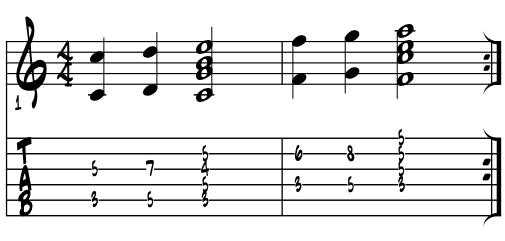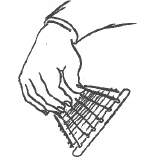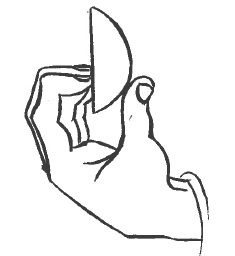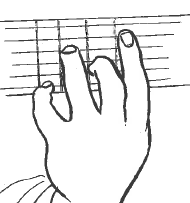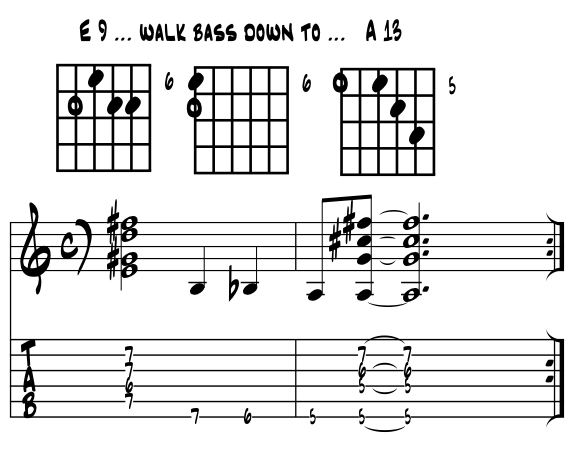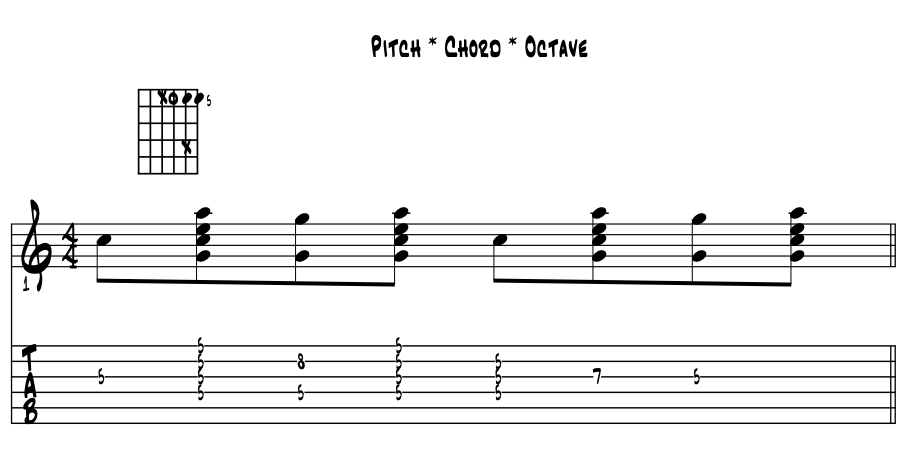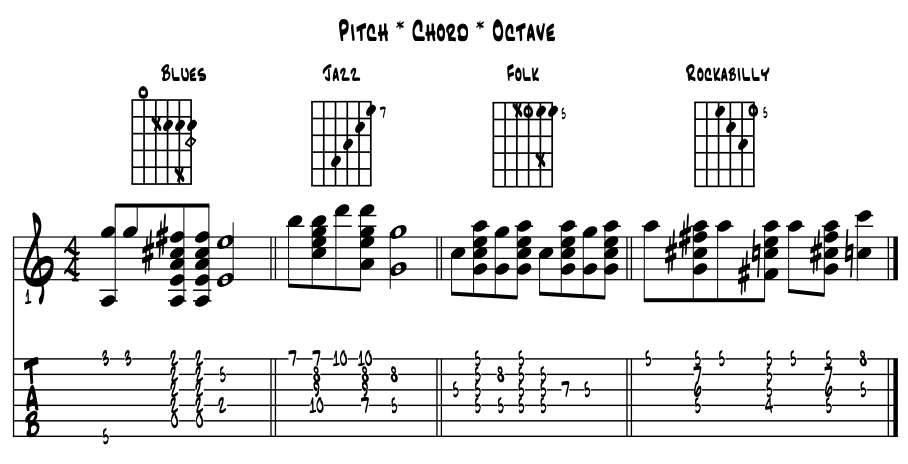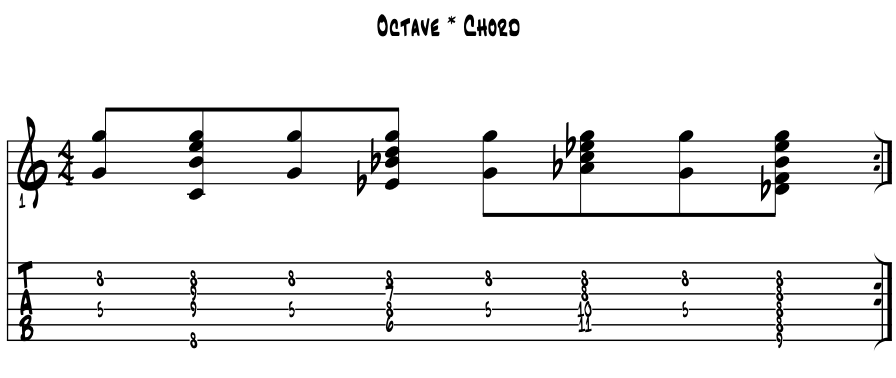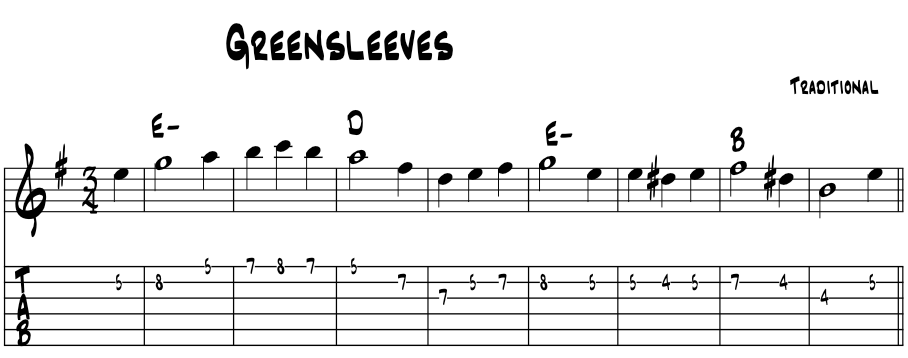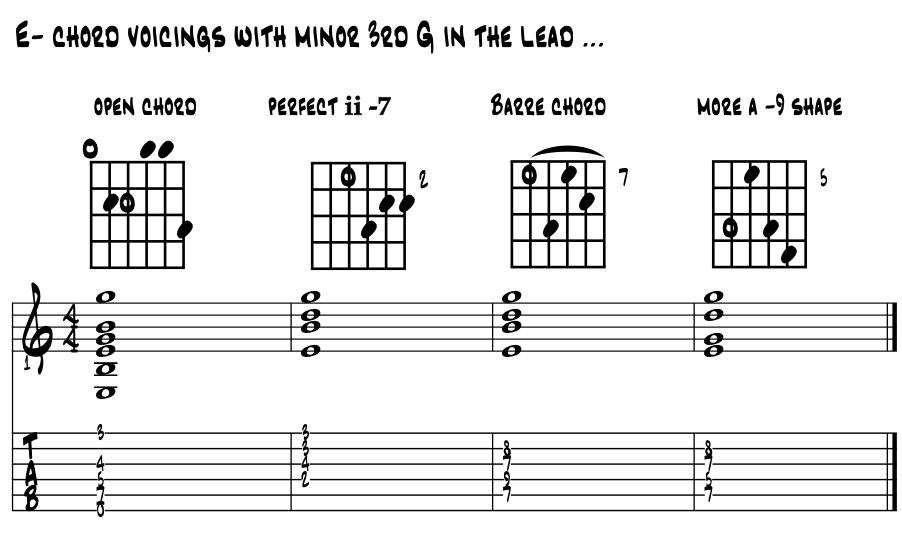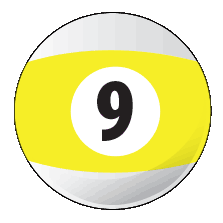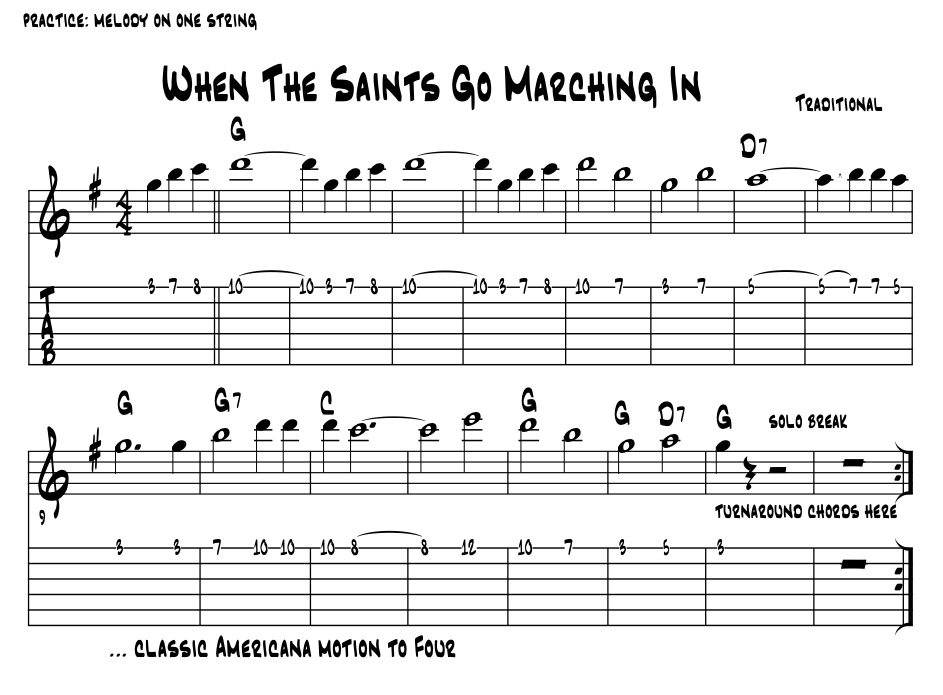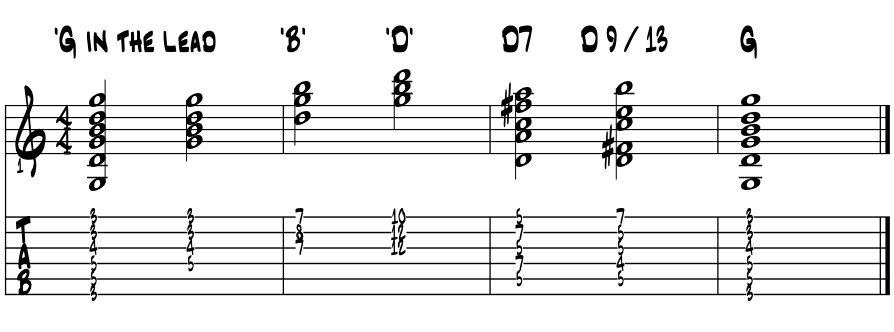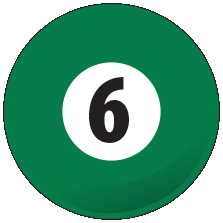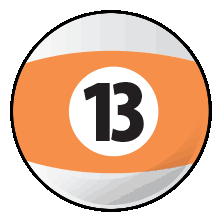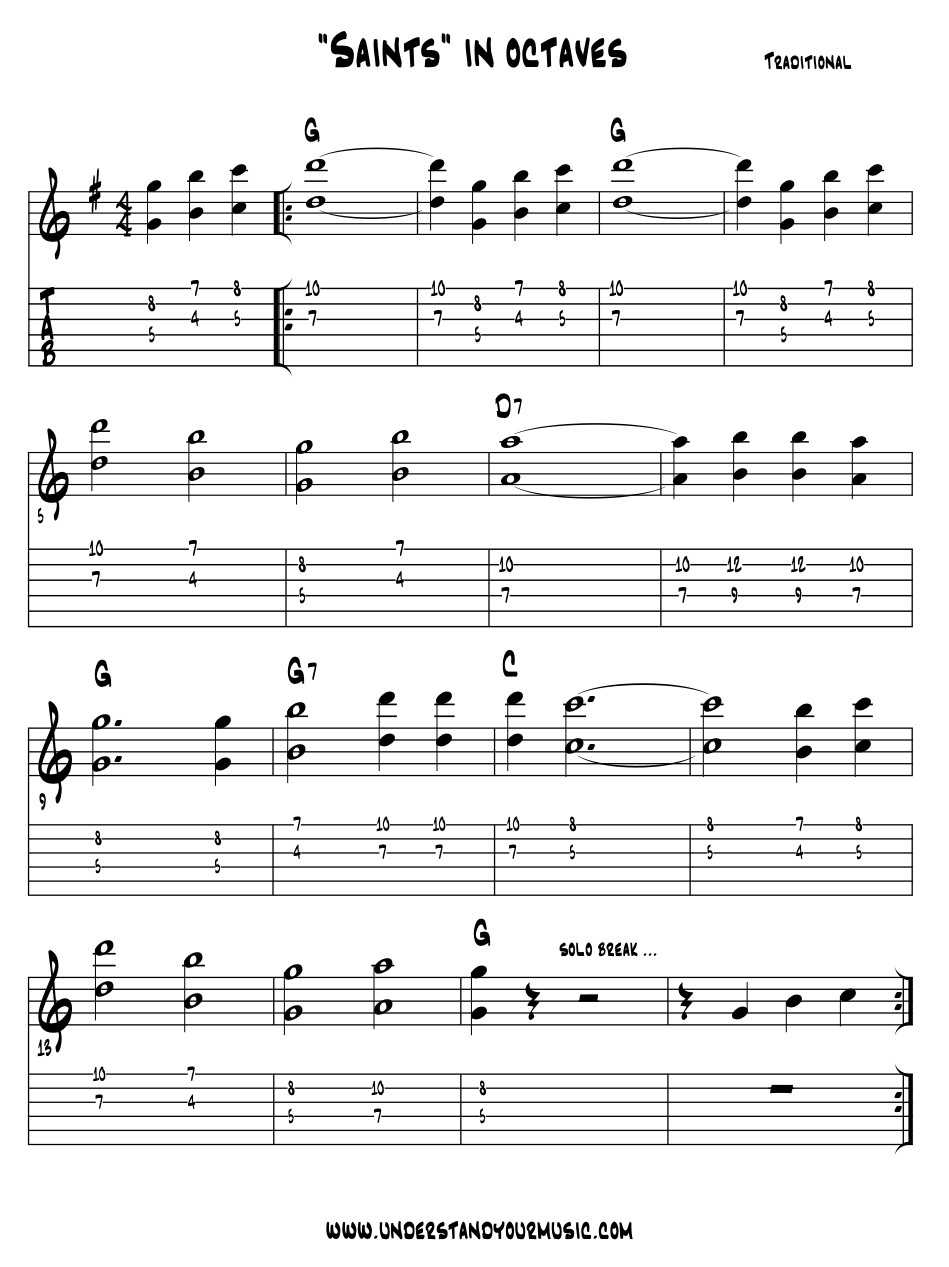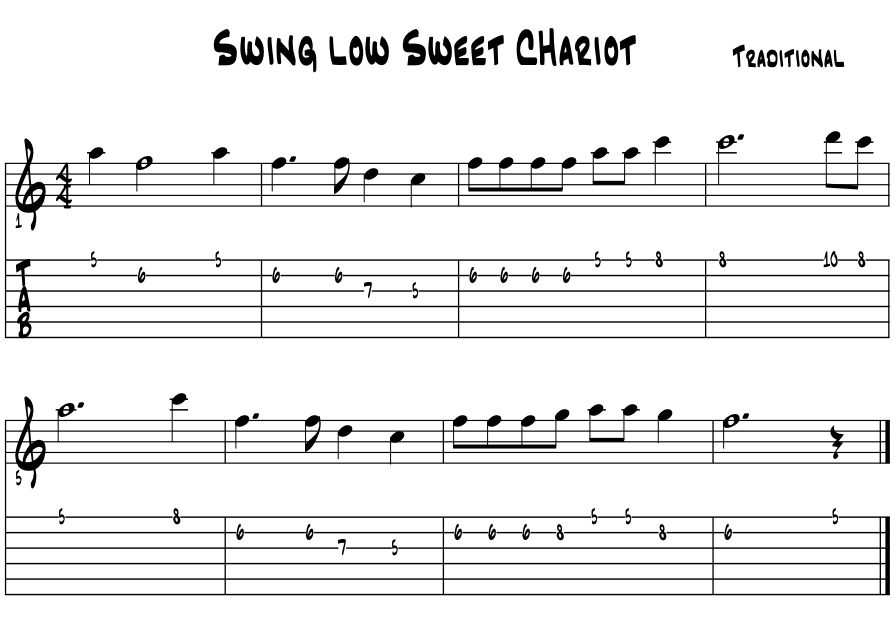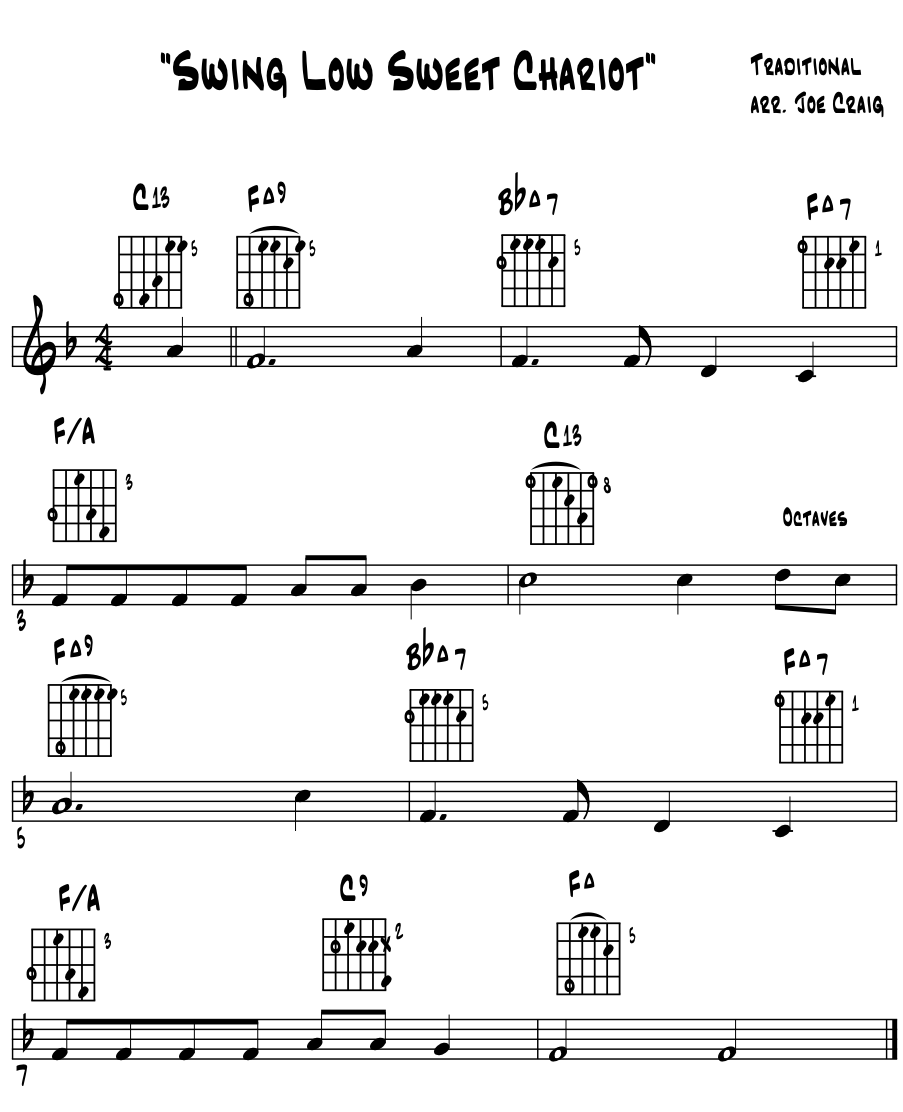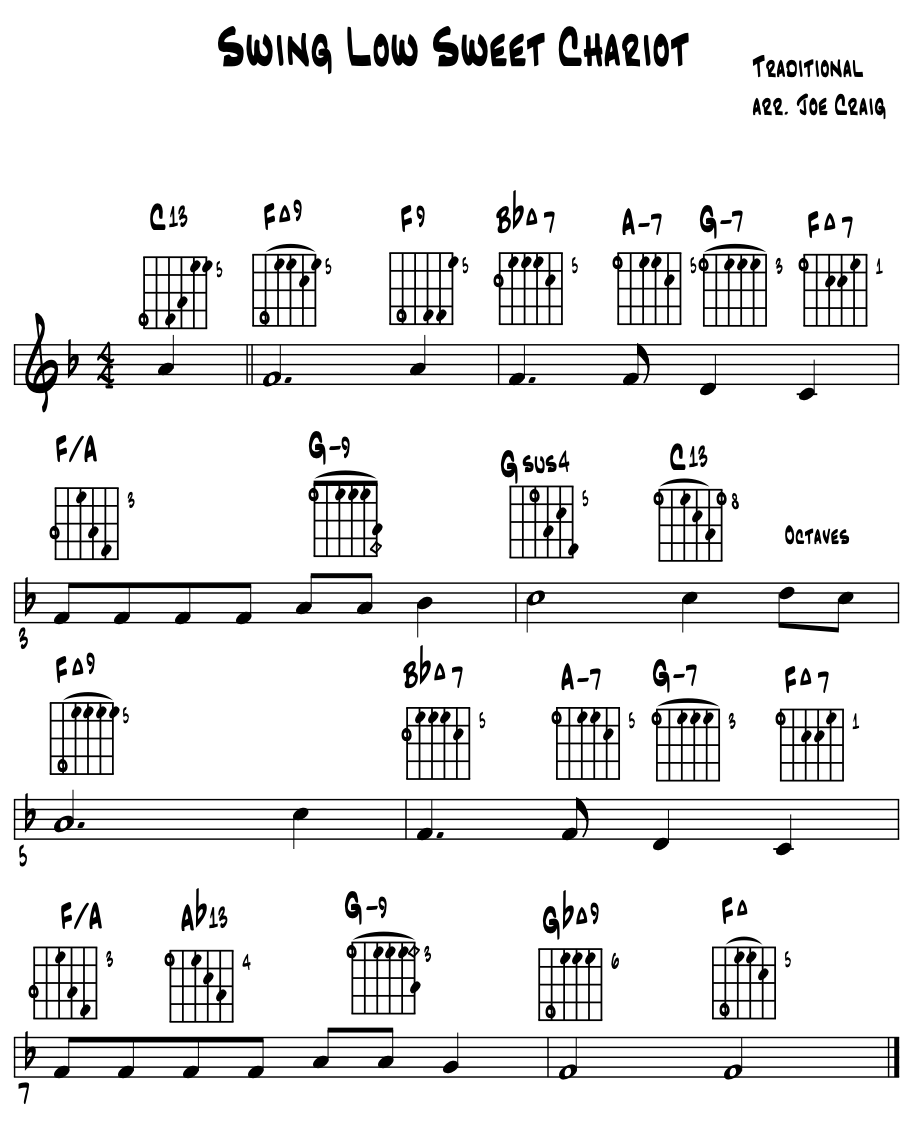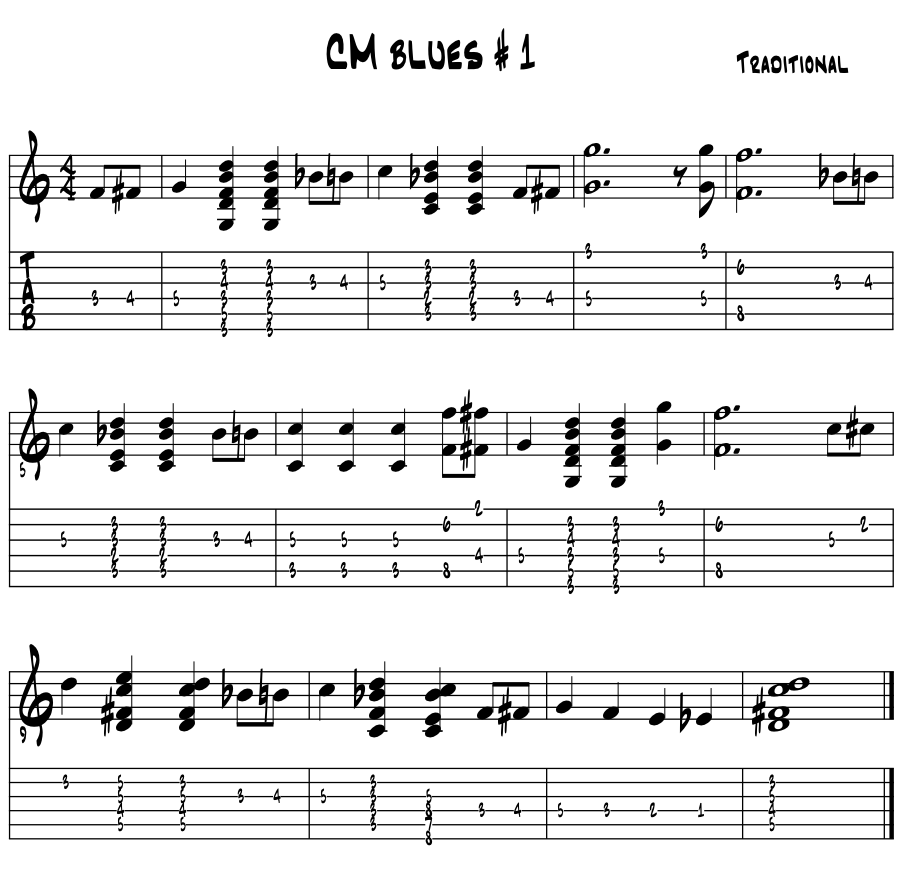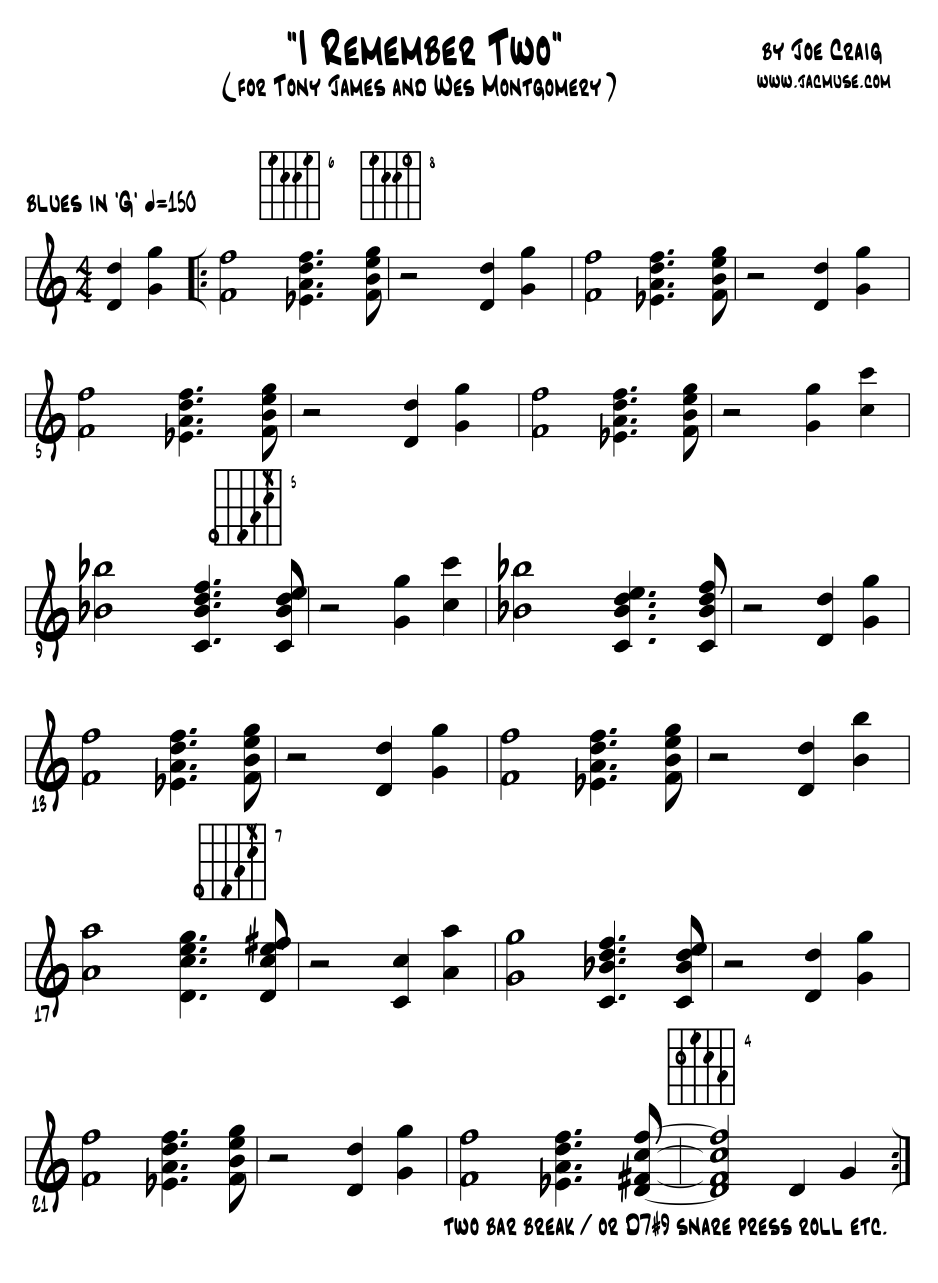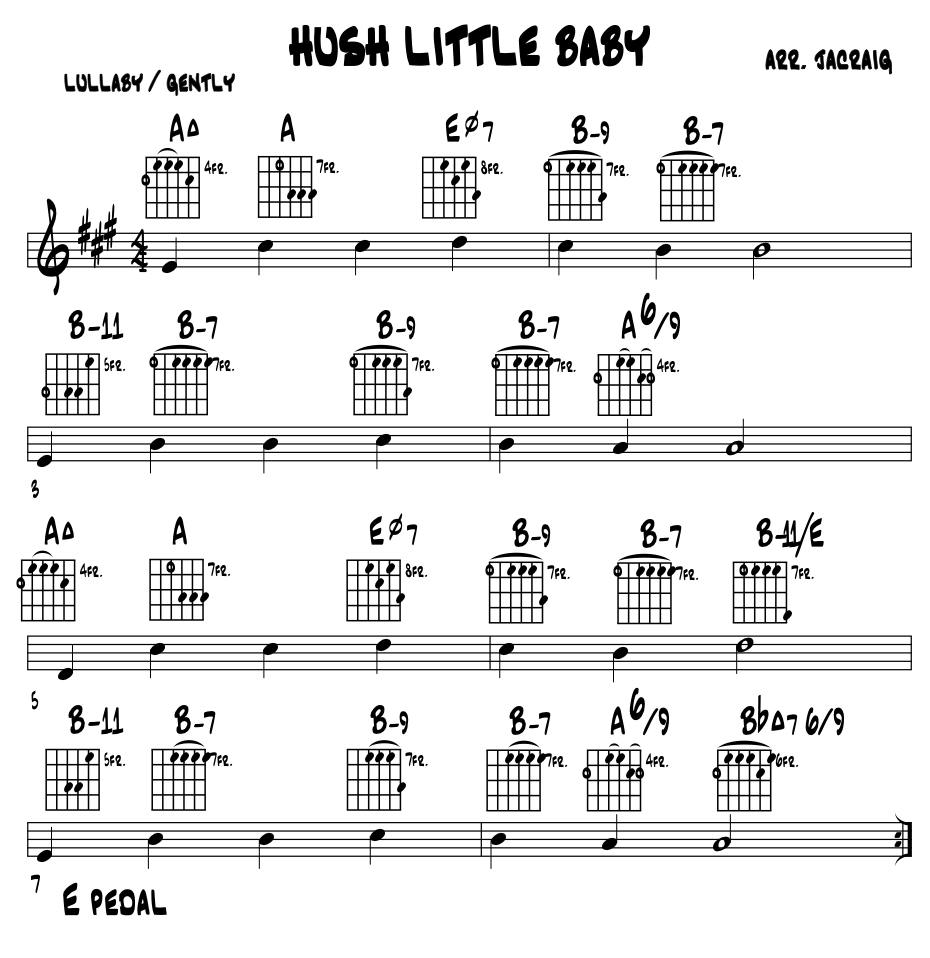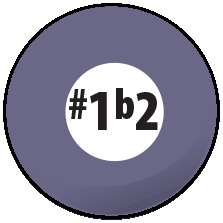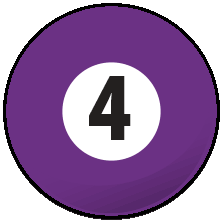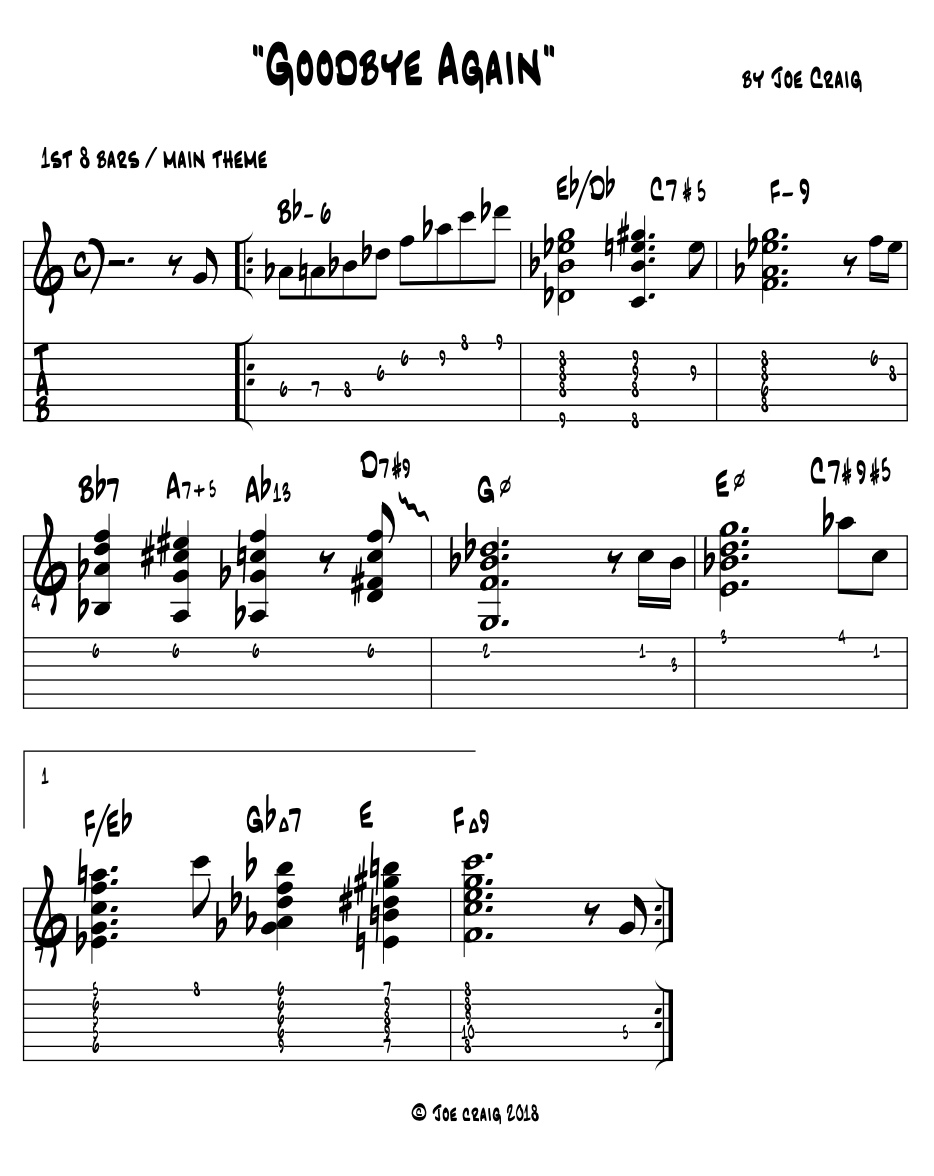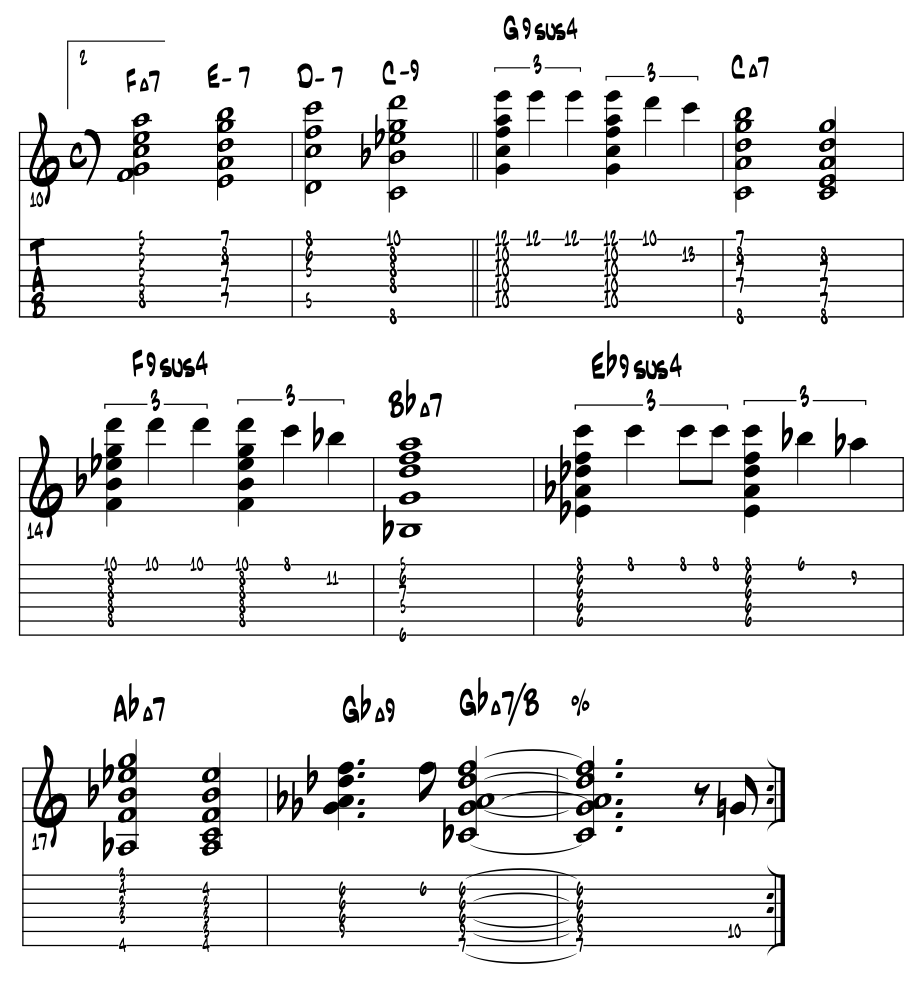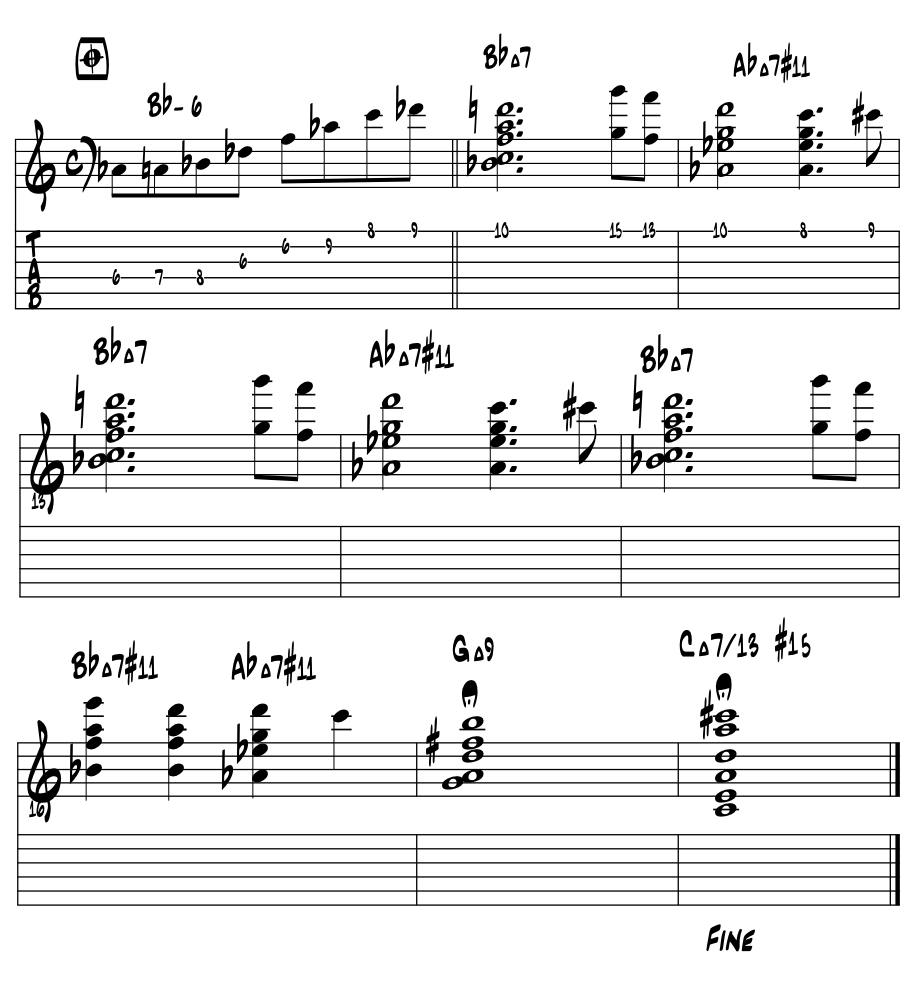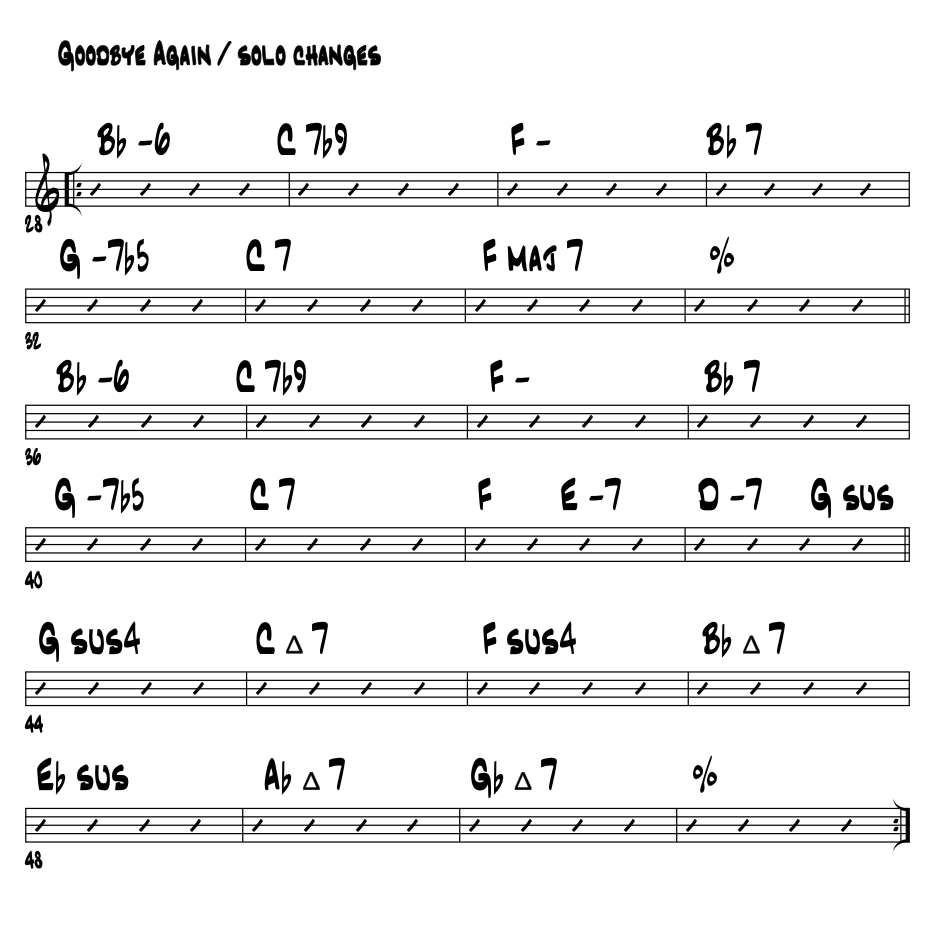'... harmonizing melody notes with supporting chords ~ ~ "Spring Can Really Hang You Up The Most" ~
|
In a nutshell. Thanks to all the instrumental storytelling coolness built right into any ol' six string guitar; melody, arpeggios and chord pitches are built right on top of a wooden drum for keeping the beat. As an easy traveler, the guitar has historically been in the center of a lot of music, for a lot of artists over the past few centuries. So now today, we guitarists inherit a lot of very tried and true ways to successfully play a song's melody and harmony together in rhythm in an arrangement. |
For advanced artist ... after a while. So after rolling on down the 'Chord Melody Road' for a few miles, with the seven diatonic puzzle pieces and five spots between in place, and woven through a couple of songs with a super clear melody / rhythm line, weaving a 'soft ~ loud' dynamic structure through the puzzle pieces of an arrangement can become a 'next portal' pathway to bring a greater expressiveness of passions. |
'Advanced fingerstyle.' A tricky aspect of chord melody guitar, especially for jazz leaning cats where songs have many different melody notes and lots of chords, is developing our musical lines whereby the motor hand fingers can play a bit of melody, then switch to octaves, then maybe pepper in a chord or two, then push off the barline in time and find a single note riff setting up the next phrase. Working out a stock arrangement that swaps around these elements is a way to start strengthening our thought process; so we'll eventually improvise these sort of interpretations on the melodies we love. |
'Fishtank concept.' This idea comes to us here from drummer Peter Kriff, who during rehearsal at music school often described what our music could sound like. Kriff would describe 'the fish tank concept' ... for its visual representation of the 'soft to loud' volume associated with musical dynamics, and that our band's collective sound weave would benefit from this visualization; that a continuously shifting volume dynamics coupled with each instrument's contribution to the mix moving from foreground to background. |
For even as seconds pass, many of the characters in the fishtank change places; move to the back, scoot to the front, whatever. Our music characters, our melody notes, bass line, chords, riffs and rhythms, in a chord melody arrangement, can also move 'to front / to back, simply by how loud or soft in volume they are in relation to the other puzzle pieces, while moving through the landscape ( form ) of a song. For like spoken word, it's often not 'what but how' we say it, that conveys the nuance and depth of emotion / passion of our ideas. |
A first riff. And while each musical style has its own favorite ways to tell the story, they can all share the same elements in common; often a mix of single melody notes moving into a chord and back to melody notes then a chord or two, add in a fragment of a bass line to direct the chord progression. Everything is cool if we can make it all make sense, musical and art. So if first venturing into this way of guitar playing, start by getting this next idea under the fingers of three diatonic melody notes; the first two pitches, the root note and 2nd are 'octave doubled', then sliding into the third melody note, sitting as the major 3rd top note of a cool jazz major 7th chord voicing. First in 'C' major, then up a string set to 'F' major, this next idea loops a couple of times so jam along, click it again and jamm to master this motion your own ways. Example a. |
Cool ? Working this up in time gets our chops, and our thought process, switching back and forth between single note lines and a chord shape while moving through measured musical time. Mastering your own way of this physicality opens the chord melody pathway for creating your own chord melody arrangements. |
Chord melody guitar. As our title implies, in a 'chord / melody' we combine our melody notes and supportive chords into arrangements for creating and presenting a song. It's an instrumental style where the guitar takes over for the vocal line. So we'll usually try to keep the melody notes up on the higher strings; the top 'E' and 'B', where we can really sound them out loud and clear and nice, in the character of the song we're interpreting. |
And since chords have a couple of pitches, and a melody note is usually just one note at a time, near all of our tasking here is to find a chord voicing that has the melody note on its top, so as its highest pitch / top most 'voice' of a chord shape, where it's generally easiest to hear and sound out the melody. |
For just like our choirs of old and today, our chosen chords will have a bass, tenor, alto and soprano note, (with jazz chords this becomes a root, 3rd, 5th and 7th) just like the sections of a choir; melody note as the top pitch of a chord, bass, tenor and alto notes below. Please examine the following lead sheet style chart. |
Creating chord melody can sort of go like this. Thinking in the key of 'A' minor, our first chord symbol, 'A-', supports the melody note 'A', so we need an 'A-' chord shape with the pitch 'A' in the lead, so it's highest note, so on the high 'E' string. Second measure; a 'C' chord with the melody note 'C' in the lead; its top note. Third measure; 'D' chord,'D' note on top, in the lead then a 'C' note. Two options now; find a new chord shape with a 'C' on top, or by moving some fingers around, and find a 'C' note in the first 'D' chord voicing. In the fourth measure we need and 'F' chord, with its major '3rd' in the lead. |
What happens in between the above chord melody building blocks is up to the artist. And the more audio versions of this song we hear by different artists, chances are we'll be hearing different was of getting from one chord to the next, varying rhythms and chord voicings and chord substitutions, so all of the above really ... and then there's the lyrics to consider too, which knowing the poetry / lyrics of a song can deepen our own expressions of those thoughts and story. |
Quick review. So cool with 'all of the above ?' And have a way to start creating chord melody arrangements on your own ? Ask your mentor for help along the way. So a lot of what follows is about chords and creating arrangements and how, in songs with distinctive melody lines, we puzzle together chords to enhance how our melody notes tell a story's song. While there's a certain degree of literacy for reading music notation that facilitates learning how to create chord melodies from a lead sheet, once the basic theory is in place, artists who work by ear might gain a wee bit of advantage in getting their own mojo into a song, doing it their way without the pathway / roadmap that written music provides. |
Author's note / jazz. As there's a major instrumental section in our jazz library, know that there's a rather vast catalogue of chord melody artists and their work to explore, covering a wide range of complexity, both in chops and theory. Thus, in creating chord melody arrangements of jazz style songs, so melodies with '7, 8, 9 even 10' different pitches, even a rudimentary ability with the notation symbols can dramatically accelerate the creative process by having a song's chart with the written melody line and a suggested harmony in support. That there's a five foot pile or so of one page written songs to try out just might be reason enough to become familiar with the notation symbols and how they function. And as these following discussions are guitar centered, knowing the letter name pitches up the fret board is a great learning accelerator. Combined; Why by knowing the notation symbols and letter name pitches, we just have to find a nice vibe and groove and start pushing the buttons :) |
The literature. We've books, scores, charts, collected works, audio, transcriptions, why near the whole classical guitar repertoire is chord melody style. And know that there are some schools of thought that place chord melody arrangements for guitar at the apex of the artistry the instrument is capable of. Surely as guitar players we've each seen some chord melody guitar magic along the way, so know what 'truly amazing' music making is when we see it :) |
And historically ... We can go all the way back in our guitar histories through to the earlier lute players, with their 'rule of 18' gits for their traveling minstrel shows. And if we hadn't had that big blaze in Alexandria in 48 BC, we'd know a lot more about the history of this history and so forth. That' be cool :) Oh well, mysteries are cool too, as are research, discovery and the just joy of figuring things out as we go along for those so inclined. |
|
Learn one song all the way through. As with any of our studies, song's are generally what we play when we share our musics. So anytime we can combine studies in a song, well we're getting the best of both in our learning. Learning one song 'stem to stern' simply begets another, and another and onward. |
The claw ~ motor hand. The motor hand is named the 'claw' throughout these discussions, the one that sets the strings in motion for you. Fingerstyle, so no pick, is probably most common sounding out chord melodies. Learning to play single note lines with the just the thumb, and various combinations of thumb and fingers combined and surely the octaves with a thumb, fanning across the strings is common. Looking 'classical' :)
Four fingers / four strings is also a basis the classical cats love. Using three fingers of the motor claw lightens the texture of the sound produced as there's one less note in the mix. Way back now, Ms Maybelle Carter originated a mostly two finger Americana motor, a banjo to guitar transfer of technique; a thumb / flick down' (index) is repeated and creates the rhythm groove of the song. Thumb gets the bass note, 'flick' gets the chords and melody notes.
Clawhammer banjo picking is three fingers yes? And when you've a bass player on the gig, using just three fingers really opens some space for both voices to move along together :) All are good, no right or wrong, just find your way. |
Basic finger techniques. In these last visualizations, we combine classical guitar and jazz techniques. 'Daylight' gets us on the tips of our fingers for faster single note articulations. Four fingers / four frets is a common fingerboard approach in jazz. Blues players that bend a lot of notes often use three, even with ring and pinky acting as one for added strength to push strings around. |
Grab the bass notes first. Chord melody playing involves juggling a few things at once. Oftentimes a 'next' chord is a challenge to get to. An easy solution is to play the bass notes of chords first, then fill in the other fingers once the bass tone is sounded. Thinking blues in 'E', motion of One to Four. Example A. |
Cool ? A handy bit of bass line and chords bluesified :) New chord voicings by chance ? Totally movable and root in position. |
The process / working from a lead sheet. Making up a chord melody arrangement from a written leadsheet is really just one of our many puzzles we have in music. And since there's like 50 leadsheets included in this book, we'll build up from the paper some of the time. It's the same as by ear but helpful and a bit easier once we know the symbols and can find them on our guitars :) |
A lead sheet. A lead sheet is usually the melody of a song written in standard notation and chords designated by the letter of their root pitch. There's really no end to the variations of this, everything from legit publishing to back of the envelope and pencil. Any way we can write an idea down that captures its essence, that will remind us how it goes, counts towards being a sort of leadsheet. |
Three basics to tell any tale. With chord melody music we've three super solid components to mix together. Melody note, octaves and chords. So the theory, easiest trick in the book, kabooms our puzzle making abilities here. Play this next lick a couple of times, which combines a melody note with its chord, then using just the sleeker octave for the next melody note, and close with a full chord to support the closing melody note of the phrase. Example 1. |
|
|
Cool huh ? Yea makes for heck of puzzle to remember. Here's a few more ideas along these lines of pitch to chord to octave thinking. Example 1a. |
Cool huh ? The rockabilly lick is a swing built right in sort of thing with a blue 3rd close :) |
Octave chord octave chord ... This next idea leans jazz mostly, blues too of course, but more jazz. Our technique is to play a melody note doubled as an octave and then fill in the chord around the shape. In a turnaround or cycle of chords, it can go like this. Example 1a. |
|
Cool huh ? Pedal tone'ish too ! |
"Greensleeves" ... we need an 'E' minor triad with 'G' in the lead ...' Ever here that phrase? With a hip hop groove and some spoken word, the words of the phrase sounds sort of like a possible hook for the 'FoneZombee's band :) How about the phrases ... 'we need a ...' a 'C' major chord with a 'B' in the lead. or a 'Bb' 7 chord with a 'G' in the lead? So in the last two statements we define the chord we need for solving for a piece of a chord melody puzzle. We include its root pitch, whether its triad is major or minor, its chord type and one color tone for each. |
As chord melody creators we're often asking these sorts of questions, its sort of our mantra I'd imagine. And as a mantra thus qualifies as a STGC'er. For when you can ask this question, understanding what you're looking for enables you to find it by your own searching. |
So from this point forward that's the goal here. To understand what's needed and where to get the parts to make it up, put it in place. Once here, you're really good to go on your own. For your own search power is energized, forevermore :) In this one question most of the elements of making music and chord melodies are there; root motion, triads, colortones and chord type, all of which will evolve as we evolve. |
We get lucky. While it sounds like a lot and it is at first, know that in working out our music this lead sheet way we're bumping into this needing a particular chord with a particular melody note all the time. Luckily, we've movable forms, so even by learning just a few chord melody voicings we sow for a mighty harvest of harmony indeed. Lots of players use capos which can solve huge fingering problems. And after learning and creating a half dozen or so chord melody arrangements, same shapes start to come around, a lot. Usually by then, the next evolution has already begun. |
And with today's various notation and playback features, we get a couple of ways of help to solve the puzzle. This is a BIG plus for those of us challenged in the reading of basic notation. That said, writing out a lead sheet is a great way to begin learning to read and write music. |
With a leadsheet we get a map of the composer's intent as to how their song goes. As artists we've just to match up the pitches and chord symbols, catch their rhythms and find these buttons on our gits, to bring a melody off the paper and into life. Here's a bit of a clip of a lead sheet from a song from waybac, one we all might know. Click to hear the line, and maybe even begin to learn it here if need be. In 'E' minor. Example 1. |
|
Finding the chord for a melody note. So right out of the gate after the pickup note, our lead sheet tells us we need an 'E' minor chord with a 'G' note on top. OK. 'G' is the minor 3rd of an 'E' minor triad. So all we need to find is a chord shape with a 'G' note in the lead, the top note of the chord voicing. Here's a few 'E' minor chords with a 'G' in the lead. Example 1a. |
So a couple of initial chord choices for covering the chord, an 'E minor triad with a 'G' in the lead, choosing which one depending on your own best chops etc., or find or create another. We can follow this basic process for working any song in any lead sheet format. Create us some puzzle pieces to fit together to make the song go. Spelling the chords is a real key in all of this. And knowing the letter name pitches on the neck seals the deal to locate the pieces we create. Everytime :) |
This works in any style too, for any lead sheet, but keep an eye on color tones and rhythms, as they play big in making a style styling in that style :) As "Greensleeves" is an old timer now, it's been covered in lots of ways. We choose the songs to play because we dig them. They sound good to us right ? Thus whatever you come up with will be your positive expressions of the melody, which in this case a cool, new and unique take of a now 400 year old melody. |
|
And deeper so if you learn the words, for they deepen their pitches. Melodies we love that also have words we love, end up being our most heartfelt felt expressions in our music. Just seems natural and right. Any other ancient melodies here? Sure. Comments or questions? |
The process / working mostly by ear. When working a mostly diatonic melody by ear, usually we'll hear where a song's chords want to be. For in most cases, there's really only a couple of places where it'll go. Remember that part of the diatonic magic, that sphere of pitch bliss where everything plays nice together, is the relative major / minor pairing for key centers, all the modes and , three chords and the truth for major and three chords and the truth for minor. |
With a song in a major key, we can start by playing the One chord, over the whole song while singing the melody notes aloud. In doing this a couple of times we'll begin to hear the Four and Five chords and where they should go. Usually Five goes first in closing out the line and form to begin a gain. Motion to Four is a core of Americana, so very very common. We can just trust the line to tell us what it needs. Exact same One / Four / Five motion mostly for songs in a minor key. |
Once these principle chords are settled, there's generally the three diatonic minor triads remaining to consider. Six, as the relative minor is probably most common. Motion from One to Three then Four is also. Two and Four are close associates in this so might swap for one another before Five. Two / Five is leaning jazz. In minor keys, much the same swapping but giving the minor One / Four / Five chords preference. |
When working with diatonic triads in composing, the melody pitches usually determine what triads will work on what pitches. As there are only the three notes to consider, triads are a bit more sensitive than 7th chords and beyond, to non-diatonic, non chord tone pitches. |
Then the artistic side of this kicks in. And you'll hear it and know if it works for you. By playing through a melody and fitting in chords, your sense of the art will decide. Is the melody begging for a Three chord before Four? Does the melody indeed go to Six, the relative minor as in say "Amazing Grace?" Building up the different melody notes available diatonically to each chord is sort of the basis of cooking up this tamale. And nothing is set in stone really, and down the road it will probably evolve as our ears evolve :) |
And then there's the blues. Chord melody playing in the blues is mostly predetermined by the historical ways the music goes. Just learn the basics of the form and chords and take it all over the world for the same basic approach to playing the blues. It's global now yea. This solidness helps us pepper in substitute chords in between the pillars. The bass line often setting the direction for the chord placement in the form. Leaning jazz here, each new chord added becomes an opportunity for exploration for the improviser working through the changes. And there's a lot here to explore. |
"The Saints" ... and away we go.' With the 'by leadsheet / by ear' ways just described, let's build up chord melody of an Americana fave using both. Know mostly by heart for some readers here, so already rote memorized :) Working from Mr. Louis Armstrong's recording of this song from back in 1938 recording, we work in the key center of 'G.' Coolness prevails yet again as the stars align decades later, as this ties us right into the key center for exploring and getting the five core scale shapes of our jazz guitar method under our fingers. |
|
In the first pass we find the melody pitches, all of which live on the top string. Example 2. |
Top string Americana! Find all the pitches? It is tricky at first just working the one string for the melody notes. Just give it a couple of tries. The whole tamale on the one string, nice. Can you stop on any pitch and find the 'G' scale below on the lower strings? ATFAW? Now we need chords for the pitches. |
Melody and chords. In our melody we've the notes 'G, B, C and D' starting out with a 'G' major chord then the pitch 'A' and 'B' in measure 7 that calls for a D7. In starting, we're just looking for various 'G' chord voicings that have these tonic triad notes as their top pitch. This first chord shape is fairly common, followed by a few more triads moving up the neck. Example 2a. |
Cool? Starting to shape up already :) Recognize some shapes? Just tonic function, One chord voicings built on the root pitch 'G' with different melody notes up top, created from the triad and key center pitches. Now for the D7 ( V7 ) chord. Found two common shapes, one for the 'A' and a different shape for 'B.' Oh, and does the guitar actually sound one octave below where it is written on treble staff? Yes indeed, sounds one octave lower, otherwise huge mess of ledger lines going to the lower pitches. |
Tonic evolutions. An easy way to add some color to any tonic One chord is to use the 6th /13th colortone and even some quartile harmony on the One chords. We can 'blue 7th' the voicing with 'B' in the lead too. Ex. 2b. |
Moving to Four. Hearing this last series of chords in a four bar phrase, that last 'G'7 directs our motion to Four and off we go ! Feel the V7 direction of the line? Hear the resolution to 'C' chord ? Cool. This is the basics of tonal gravity and aural predictability, the 'pull' towards our destination, Four, and that we can peer into the future and 'predict' that indeed yes, this is where the music is going, that the arrival there is something impending, ordained to happen. |
How we each balance these two ingredients combine for creating our own unique artistic solutions to our chord melody puzzles. And they also can be an easy way to visualize and aurally understand our Americana musics in general. |
In octaves. A very common trick in chord melodies and often in jazz guitar, when the melody notes are quarter notes in a moderate tempo, we can double the melody notes in 'octaves.' This strengthens up the lines and can deepen the swing of the thing. And with the physical nature of the instrument, the way its pitches are laid out etc., the 'octavizing' of a note is right under our fingers :) Adding in a second string now, run the melody line again in octaves. Use your thumb to strum, dampening the other pitches between our target notes, or pluck with thumb and index the pitches we want. Example 2b. |
First time getting a melody 'in octaves' together? Cool. Another first. Already grooving along with octaves? Cool, then you know their power to get things to swing, swing, swing. And the original octave king? Why, most would say Mr. Wes Montgomery, who showed us the way to a new depth of swing that still holds sway today, now near 50 years further on down the road. |
|
So if need be learn about playing melodies in octaves right here, for as we'll see, the octaves often become an easy solution to the tricky parts of our chord melody puzzles, providing super solid melody notes and variety in the texture of our arrangements. And that a melody in octaves can deepen the swing in just about everything :) |
Here's the whole chart. Combining octaves, chords and some single notes, we create an arrangement of this true Americana classic. Example 2c. |
Got this up and running? Start slow for sure and work it up to your tempo. A cool thing about well crafted tunes is that they can 'work' at any tempo. That determined by the combined skill level of the players in the band. The Ellington / Strayhorn classic "Satin Doll" fits right into this style of octaves and chords. And for "The Saints?" Still makes for a memorable great break tune ... :) |
|
Melody first ~ "Swing Low." So once the melody is under the fingers, then we find cool chords underneath to support the pitches. Once changes are located, a chord progression usually appears. Then we go after it' bass line story, sure up the bass line to nicely connect the roots of the chords. Jazz it up as you see fit, maybe with a chord substitution and a bit of swing rhythms once underway. The following discussion follows a theory sort of philosophy process to create a chord melody arrangement for any song that might come along. |
A melody to start with. We build up this next chord melody for "Swing Low Sweet Chariot", a core song of our Americana gospel tradition. Six pitches in the line, basic diatonic motion and super clear direction and message make it a keeper. We start off by learning its melody pitches of the melody. In 'F', classic, earthy gospel key center. Example 3. |
Phrase the melody. Once the pitches are under your fingers, totally play them from the heart with just one finger, slide etc. Totally milk each pitch, even saying the letter name out loud. Maybe sing or hum the pitch too. Finding a melodies pitches on just one string, moving up and down as needed, surely gets all this on the same page; total from the heart every pitch connecting. |
Add in chords. In this next idea, we begin to support the melody pitches with chords. The One, For and Five begin this harmonization process. Example 3a. |
Fill in the rest. In this next idea, we fully harmonize the melody notes. Example 3b. |
|
Find any new chord shapes? This last two bar bit of Americana is filled up solid with jazz shapes. To get back to a more gospel sound, and give the arrangement back to the back vocalists, just leave out the passing chords, stick to the One / Four / Five chords, and all is well. Maybe save some of the fancy for your solo ... ? |
Play a lil' blues. In this next idea, we get into 'real time' and use a simple chromatic riff and the One / Four and Five chords in a 12 bar blues form. In G? Yep :) So thinking 'blues in 'G.' Play the riff, then the chord, there's the fast Four in bar 2, otherwise fairly straight ahead chord melody for the blues. Notice we again bring in the 'octaves' into this mix of chord melody elements, which for some players, is super super key, moi aussi :) |
This "CMblues#1" chord melody song, played in real time with a metronome, is just a very very common way to strengthen it all up, have a ton of musical fun. Learn it here now if need be, mixing single notes, octaves and chords, and be good to go on down the road empowered forevermore with 12 bar blues in a minor key. Ex. 4. |
This mixing of the elements rolls right into playing in a trio format, bass, drums and guitar. Bass and drums motor, bass plays a storyline and outlines the harmony. Guitar plays the leads and chords. 'Power trio' for the rockers; Jimi, Jimmy and Kurt C. and Chili Peppers and on and on for the rockers, power trio for the blues a la SRV, this three piece format covers a lot of ground. Getting comfortably switching up between single line, chords and octave lines and melodies within multiple measure builds a solid technique to bring it. Oh, and you can sing too? Bingo :) |
|
Play some more blues. In this next idea, we again use the rhythm of the song to set up the sounding of the chords. Got your octaves handy? Learn this next line and you'll be on your ways to a bluesier octave galaxy. In this song we end up with a 24 bar blues form. So a doubling up of the traditional 12 bars. Not really sure or why this happened, but it feels right and when written out this way, it plays back fine so we're cool. |
So, blues in 'G' again, right around the 3rd, 5th and 7th fret dots. Some would call this melody / chord style to 'pepper in the changes.' Tune on up, tune on in and play right along. Two choruses in the mp3. Example 5. |
Very repetitive? Too much? A brighter tempo brings ideas, such as changing the direction of the 'G' 7 chord pairings. Change the direction of the two main chords. Like this. Example 5a. |
Easy huh? Yea just finding new coolness with the same old same old. The only 'as written' 24 bar blues I know of is jazz tenor saxophonist Stanley Turrentine's essential jazz standard song "Sugar." Just a true gem of a song. |
|
Repetitive music. Funk music is designed this way too, nice idea repeated. Some cats just don't dig it for that reason. But it's dance music dude :) Dancers love it. And they love disco too. All about the dancers? In some ways it is for they take us back to the core of it all. And for others players? Repetitive is where it is at; repetition of the idea, a deep deep groove, usually four bars, over and over. So to each our own no doubt but in today's music, yea, nice ideas repeated, embellished, climaxed and all. |
|
And yea, change it up. Make it yours. Everyone ever in this biz has done this same thing to make new great art. Termed 'covering', it's often the easiest way up the showbiz ladder. And there's no end to this copying to find a top 10 hit. From exact replica's to total remixes and today's sampling, its art and its yours, rejoice in your creative and share. |
"Always think different from the next person. Don't ever do a song as you heard somebody else do it." |
wiki ~ Otis Redding
|
Hush! You'll wake the baby ! One for the little ones. This penultimate chord melody arrangement is a lullaby I've always known and worked up for a gig I had where lots and lots of little kids would come along with their folks during my gigs. Kids are fascinated by being able to watch hands move and sounds being made. And when they can hear a melody they know and follow along, their recognition is a marvel to behold. |
So I have a handful of lullaby melodies ready for when the little peeps and their folks come along. Mostly I just play the melody pitches for easy recognition, Moms and Pops would often lean in and help their kid's recognize the pitches and sing along too. This arrangement of "Hush Little Baby" is one that got a few chords too. As it was mostly played slowly, I was able to use a few Hollywood chords. Example 6. |
Cool? Cool. I usually play through it three times starting in 'G' then through to 'Ab' and a last modulation to 'A.' Same shapes, just moving them up for each new key center. The last chord, a Hollywood 'bII major 7 6/9, can become Four and a segue chord into a next song. |
Single note lines in chord melody. This last chord melody arrangement is one I wrote a few years back. For our chord melody studies here, this arrangement combines single note lines and chords in a sort of dance together. There's a much lightened sense of tonal gravity in the aural colors, so leaning jazz here. Presented in a couple of sections, it goes like this. Example 7. |
Second 'A' section. Example 7a. |
Coda. Example 7b. |
Solo changes. Oftentimes these 'chordy colortone' harmonies written into a tune are for the playing of the melody with the written changes. To make things easier all around, composers often include a set of more 'generic' chord changes for the soloing. Frees things up a lot, and makes the statement of the melody / harmony and composer's intent more focused it seems. Optional solo changes as they say, you decide. Example 7c. |
|
Modern leaning jazz. To close out this discussion of harmonizing melody notes we tack on a rather simple device that creates a rather modern and 'urban' sounding harmonization of even the most down to earth melodies. We use the potency of the major 3rd interval, what determines major and a key center, to orchestrate us way beyond the sounds of the diatonic while retaining the simplicity of any melody line. For example, here's three notes of "Mary Had A Little Lamb" in major 3rd's. Compare the diatonic to the moderne. Example 8. |
And on a guitar ... ? Crazy out there huh with just a bit of mix / match magic ? And when harmonizing with another instrument, thanks to the linear nature, and all things 'movable shapes' magic of a guitar, we can simple move up four frets, a major third, and the same fingerings, patterns etc., of any melody, and this harmonizing in major 3rd's will fall right into place :) And might this work with other intervals ? |
"Spring Can Really Hang You Up The Most." Into the wayback for this next story, to back when the author had a steady solo jazz guitar gig, playing my own chord melody arrangements and billed as; 'modern poetic interpretations of classic jazz songs.' "Spring" was a top request and after a year or so of gigging in this format, I created a book that included an arrangement of this song among a dozen others. Unfortunately this 'chord melody guide' was never published due to my inability to get permission from copyright holders, except for this wonderful song; "Spring Can Really Hang You Up The Most", written by Fran Landesman and Tommy Wolf. Reaching out to Ms Landesman by post, I received a letter giving me permission, for educational purposes, to include her song in my collection. Here today, and now 25 years later, my sincerest thanks to the composers for their original permission to include my arrangement of 'Spring' for jazz guitar, now as part of this free e-book's 'chord melody studies' for the modern guitarist. |
|
Review. As in being creative and the envisioning of any sort of art really, once we've our components in place, we just need to start and try. In the ideas above, we created a beginning process. Either by ear or with a lead sheet, learn the pitches of the melody of the song we are looking to harmonize and be able to play it musically. Find the pitches on the upper two strings. Once beginning to shape up, double the pitches in octaves. Once that's moving along, in either major or minor, find the One / Four and Five chords chords to support the main points of the song. Add in additional chords as the lead sheet directs, what you hear from a recording or what your ear 'tells' you belongs there. |
“This world is huge, and there is so much space for everyone to do something great.” |
wiki ~ Mo'ne Davis |
Find a mentor / academia Alaska. Always good to have a mentor when learning about things new to us. And with music and its magics, nice to have a friend or two ask questions and collaborate with. Seek and ye shall find. Local high schools, libraries, friends and family, musicians in your home town ... just ask around, someone will know someone who knows about music and can help you with your studies in the musical arts. |
"These books, and your capacity to understand them, are just the same in all places. Always bear in mind that your own resolution to succeed, is more important than any other one thing." |
|
Find a mentor / e-book / academia Alaska. Always good to have a mentor when learning about things new to us. And with music and its magics, nice to have a friend or two ask questions and collaborate with. Seek and ye shall find. Local high schools, libraries, friends and family, musicians in your home town ... just ask around, someone will know someone who knows someone about music and can help you with your studies in the musical arts. |
|
Always keep in mind that all along life's journey there will be folks to help us and also folks we can help ... for we are not in this endeavor alone :) The now ancient natural truth is that we each are responsible for our own education. Positive answer this always 'to live by' question; 'who is responsible for your education ... ? |
Intensive tutoring. Luckily for musical artists like us, the learning dip of the 'covid years' can vanish quickly with intensive tutoring. For all disciplines; including all the sciences and the 'hands on' trade schools, that with tutoring, learning blossoms to 'catch us up.' In music ? The 'theory' of making musical art is built with just the 12 unique pitches, so easy to master with mentorship. And in 'practice ?' Luckily old school, the foundation that 'all responsibility for self betterment is ours alone.' Which in music, and same for all the arts, means to do what we really love to do ... to make music :) |
 |
"These books, and your capacity to understand them, are just the same in all places. Always bear in mind that your own resolution to succeed, is more important than any other one thing." |
|
Academia references of Alaska. And when you need university level answers to your questions and musings, and especially if you are considering a career in music and looking to continue your formal studies, begin to e-reach out to the Alaska University Music Campus communities and begin a dialogue with some of Alaska's finest resident maestros ! |
|
~ |
